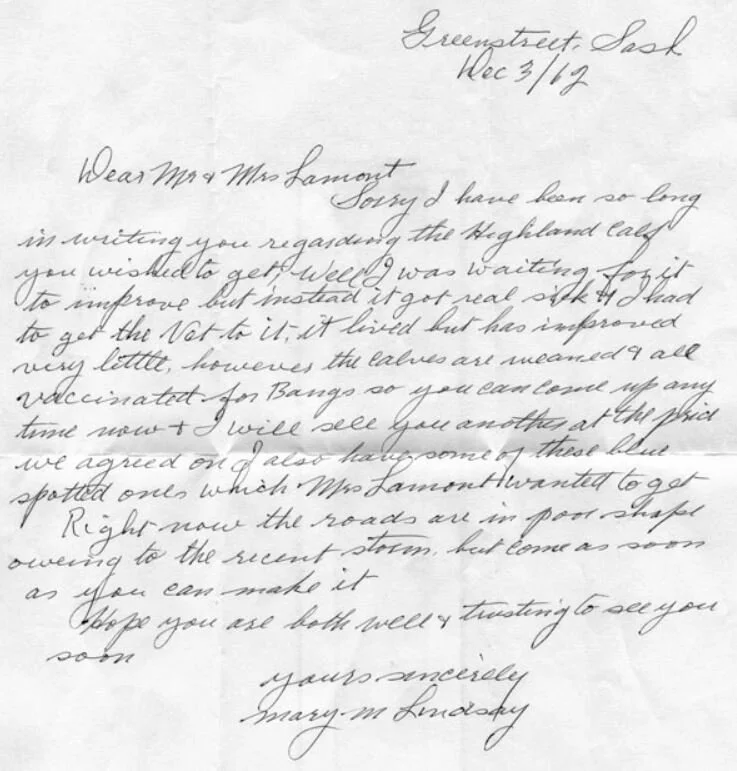Speckle Park Cattle
Speckle Park cattle are a Registered purebred breed of beef cattle originating from Canada. They are a are moderate sized animal, with mature cows ranging in weight from 600 kgs to 850 kgs and mature bulls 1000 kgs +. Calves average 30 to 40kgs at birth and are very quick to get up on their feet to drink, as they have a vigorous survival instinct.
Speckle Park cattle come in a variety of color patterns. They can be white with black points, leopard coloured, speckled and solid black. All colours are registrable with the breed society, Speckle Park International.
Breed History
Mary McKay Lindsay 1896 – 1991
Mary Lindsay was born in Forfarshire, Scotland in 1896, a land which has produced a lot of capable livestock people. In 1906, at the age of 10yrs, with her parents and siblings, she emigrated to Saskatchewan, in Canada.
The family farmed sheep and cattle and Mary had a keen interest in animals and livestock, particularly beef cattle . Many of the Lindsay’s livestock had British origins. Mary and her sister Emma owned and raised cattle in their own right, they milked by hand up to twenty cows from which they sold the cream.
Mary Lindsay with her dog at her family home in Greenstreet, Saskatchewan
In 1937 Mary acquired a heifer from her father’s herd, with a distinctive colour pattern which became the foundation cow of today’s Speckle Park breed.
She found regardless of the breed of sire she bred the cow to it always produced calves with a distinctive spotted colour pattern. It is believed that the heifer was a descendent of a Teeswater Shorthorn and a White Park bull. These two ancient British breeds dating back to the 16th Century were hardy, strong and milky. Mary continued to breed her speckled cattle and found that the speckled pattern was a dominant trait in her newer version of those old breeds. The cattle grew quickly, were hardy and quiet natured. The cattle that Mary kept from that heifer she called Linebacks.
In 1962, Eileen and Bill Lamont, Angus breeders from Maidstone, Saskatchewan, were interested in purchasing some beef cattle from Mary. Mrs Lamont in particular was interested in Mary's speckled cattle. Mary wrote to them inviting them to visit and they subsequently bought their first speckled heifer. It was to lead to the development of what is now known as the Speckle Park cattle breed.
Mary Lindsay’s Letter to Bill & Eileen Lamont, mentioning the ‘spotted’ ones which Mrs Lamont wanted.
The Lamonts crossed their "speckled" cows with their top-quality registered Black Angus bulls in the early 1960's. The resulting offspring came in a variety of colour patterns, being, white with black points, leopard coloured, speckled and solid black.
Over time the Lamont’s selective breeding created high quality carcass cattle with low to moderate birth weights. They named the progeny Speckle Park cattle. Other beef cattle breeders saw them come through the sale yards where they achieved a premium price. Their interest grew in these hardy, heavy milking and distinctly marked cattle to the stage where they started purchasing bulls and females from the Lamonts. Within a few years a dedicated group of breeders, mainly from Saskatchewan were breeding Speckle Park cattle.
Agriculture Canada approved the incorporation of the Canadian Speckled Park Association on June 4 1993 and they were declared an evolving breed of beef cattle. History was made when the Minister for Agriculture announced the Speckle Park breed a distinct pure-bred breed, on July 6th 2006… the first and only breed to be developed in Saskatchewan Canada.
Their genetics have since been imported into New Zealand and Australia, where the breed has adapted extremely well. They are now the fastest growing cattle breed in Australasia.



